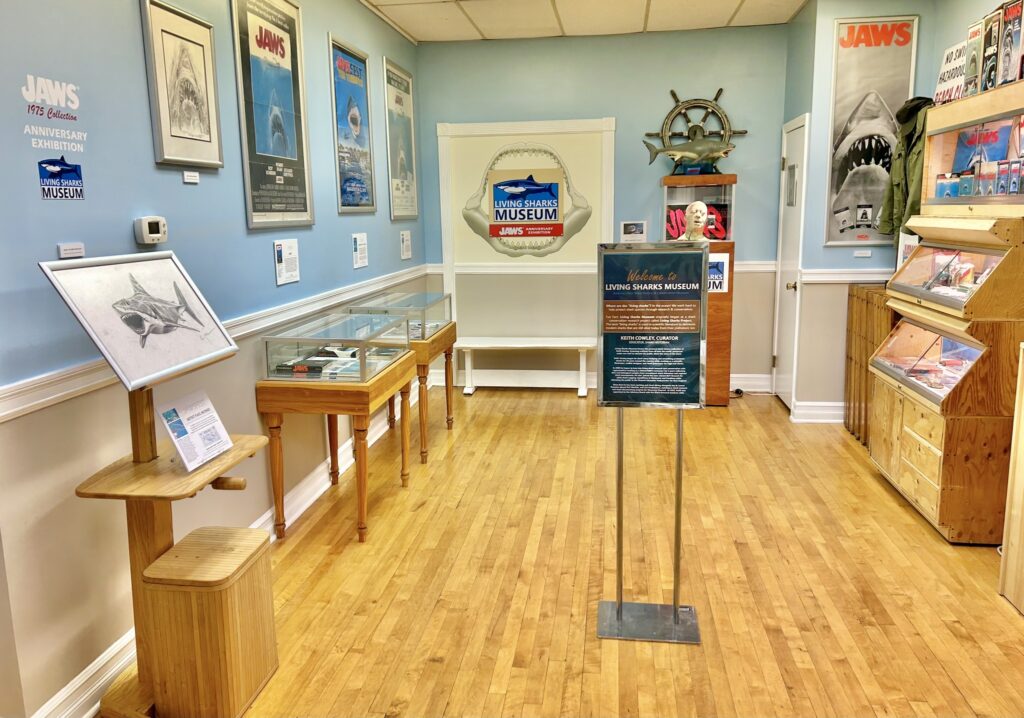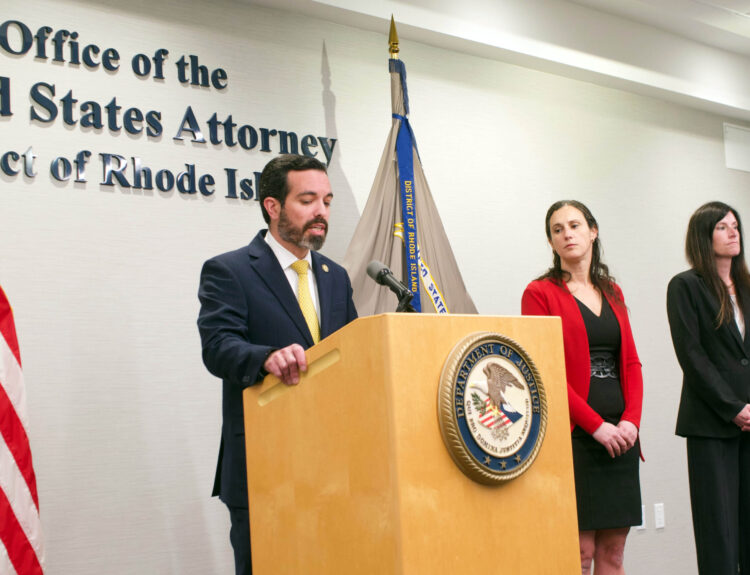Population of makos, commonly seen off Rhode Island, in decline
NEWPORT — This summer, reports of shark sightings seem to occur early and frequently, often in places where these fish were rarely seen like the Great Salt Pond on Block Island, East Beach in Charlestown and Third Beach in Middletown. A dead shark recently appeared in front of the Ocean House in Westerly.
Beachgoers are concerned because sharks have been hyped up for years as scary and dangerous (this summer happens to be the 50th anniversary of the release of Steven Spielberg’s classic Jaws). According to the experts, though, there is little reason to worry.
“They don’t want to bite anyone. They don’t want anything to do with people,” explained Adam Kovarsky, Curator of Save the Bay’s Hamilton Family Aquarium in Newport, where visitors can actually pet sharks and other sea life in sensory-engaging touch tanks.
Sharks were once seen as dangerous maneaters, but they’re more frequently regarded as a vital part of the Earth’s ecosystem.
“The tides are turning,” said Keith Cowley, Curator and Shark Historian at the Living Sharks Museum in Westerly. “It’s not a message about fear anymore. It’s about fascination.”
Except for mako, sharks are thriving but not dangerous
“Some shark populations have gone up, but it’s not like there are sharks all over the place,” said Professor Bradley Wetherbee with the University of Rhode Island’s Department of Biological Sciences, in response to the question of whether we’re seeing more sharks in the area.
For decades, the number of sharks around the world was on the decline. To combat overfishing, protections were put in place and, after many years, the fish are making a comeback, particularly white sharks, which accounts for the increased awareness on the part of beachgoers and boaters.
But sharks don’t call attention to themselves. It’s humans with their phones and drones that capture their images and share them across the internet.
Wetherbee theorized about an increase in sightings: “The media call a lot of attention to sharks. I’m not sure that the reality is that there are more sharks, that they’re more common. I think it’s more on the part of humans than on the part of the sharks.”
Off the Rhode Island coast, the most common shark is the mako, considered one of the fastest fish in the sea. While other species are booming, their population is on the decline, primarily due to overfishing. This consumable species has become endangered but is now safeguarded by law and will hopefully rebound.
On URI’s research vessel, Wetherbee takes students out on the open waters where they can witness sharks in their natural environment, tag them and collect data that is analyzed to draw conclusions about the well-being of the fish and their ecosystem.
Spreading the word about sharks
At the Living Sharks Museum, Curator and Shark Historian Keith Cowley sees that the public perception of sharks has become more positive.
The Museum exists as a resource and research center featuring shark fossils from around the world, along with exhibits on science technology and a deep historical literature library.
“We bring facts to people,” said Cowley, “helping them gain perspective and understanding.”
For the thousands of people who have visited and experienced the exhibits firsthand, they leave with a better understanding of the habits of these creatures.
Many people start off uneasy with their opinions of sharks but they’re just as concerned about not knowing what’s floating beneath them underwater, whatever it may be. Plus, they are regularly inundated with circulating media coverage about sharks.
The museum shares the history of sharks through visual artifacts. Despite a longstanding relationship with them, humans know little about them.
Cowley adds, “People need to be educated about the conditions that could lead to interactions so they can avoid them, protecting themselves and the sharks.”

Getting up close and personal
Shark lovers are lucky to live in Rhode Island, where there are plenty of opportunities to explore these fascinating creatures and even experience them firsthand.
At Save the Bay’s Hamilton Family Aquarium in Newport, visitors may come face to face with the various species that live in and around the waters of the Ocean State. The Aquarium hosts two types of sharks: smooth dogfish sharks, found in more shallow areas and chain cat sharks which thrive in deeper waters.
According to Aquarium Curator Kovarsky, neither species poses a threat to humans.
“The sharks in the touch tanks are completely harmless.” Visitors can get up close and personal, gently petting the sharks in their touch tanks.
“Most humans’ gut reaction is fear,” adds Kovarsky, “whether it’s biological or because most people have seen Jaws at one point.”
Kovarsky emphasizes that there is no need to be apprehensive, “A big goal of the Aquarium is to show people the amazing life in Narragansett Bay to encourage them to make good decisions. People are amazed to see and learn about the life under the waters around us.”
All sea life at the Aquarium, including the sharks, is found in local waters like Narragansett Bay and the Rhode Island Sound as well as freshwater locations.

At Biomes Marine Biology Center in North Kingstown, exhibits are focused on the sensory experience. Aquarium Manager Mariah Branch explains that visitors can use all of their senses to better relate to the marine life.
“You’re seeing the animal, you’re hearing the water movement, you’re hearing them move through the water and you’re touching them. You’re feeling that whole experience. That really fosters and cements the memory and the care.”
The hope is that this connection will build respect between humans and animals who must share this planet together.
As Branch describes, “Being this close, it creates a relationship. between you, the individual, and an animal, also an individual. There’s so much we can learn from one another.”
Guests at Biomes can see dogfish sharks and a distinctly colored bamboo shark, whose species developed markings to blend into their environment which both protects them and makes them better able to catch their prey. Plus, she can walk on her fins.
Branch explained: “She’s so beautiful. And so different. She’s really fabulous, because she can help us teach about different adaptations.”
A summer to remember
All of the experts agree that the best way to reduce the stigma of sharks as maneaters is through experiential education. By getting to witness sharks firsthand, people realize that they are not a danger.
But not everyone has that opportunity. That’s why Professor Wetherbee, through URI, created Shark Camp, introducing young people who are often underrepresented in the study of marine biology to the field.
Wetherbee describes how Shark Camp came to be: “Years ago, I noticed that Marine Biology is very homogenous. There were very few students of color participating so I had this idea of starting a camp so we could get these kids, mostly from inner cities, to go out on a boat, catch some sharks.”
Every summer, sixteen students from local schools are selected to join in a week of fieldwork aboard a research vessel through URI. For many, it’s their first exposure to the natural sciences and often their first time on a boat.
“Something I feel strongly about,” said Wetherbee, “is giving people an opportunity that they wouldn’t have otherwise. It makes an impression.”
The hope is that, as a result of their experience during the summer, our campers will be inspired to explore their options to attend college and continue their studies, whether in marine studies or in any area where their interest lies.
The more you know
Sharks have lived on this planet millions of years longer than humans and will probably survive us all. But they are not the dreaded monsters they’ve been portrayed as in countless films and books.
As we continue to learn more about these magnificent creatures, experts say, people can understand that we will be able to cohabitate as long as they treat each other with respect and maybe a little bit of wonder.
Watch the Documentary, Chasing Fins
Rhode Island PBS recently premiered Chasing Fins, a short film featuring the Atlantic Shark Institute, a Rhode Island–based nonprofit dedicated to shark research, education, and conservation.
Learn More
Biomes: biomescenter.com
Living Sharks Museum: livingsharks.org
Save the Bay’s Hamilton Family Aquarium: savebay.org/family-fun/aquarium
University of Rhode Island’s Wetherbee Lab: web.uri.edu/wetherbee-lab






